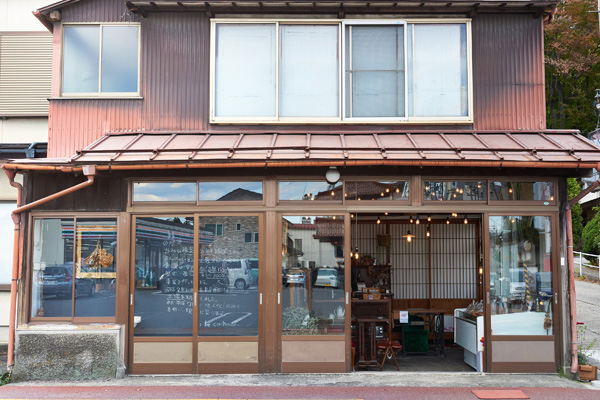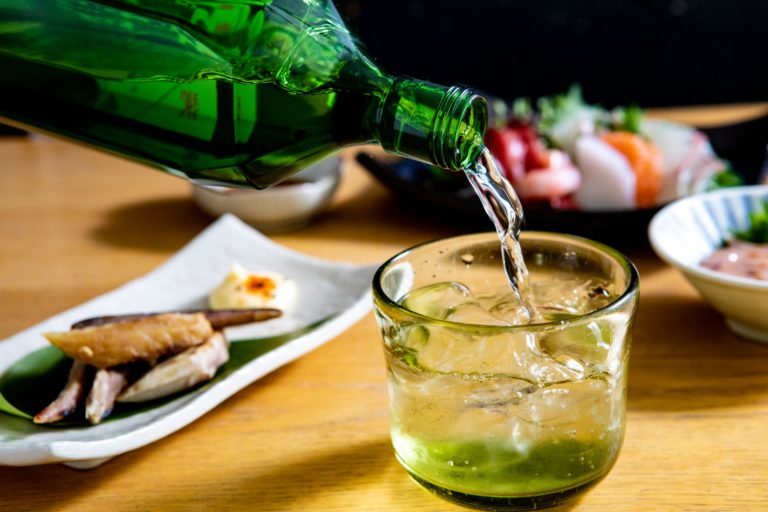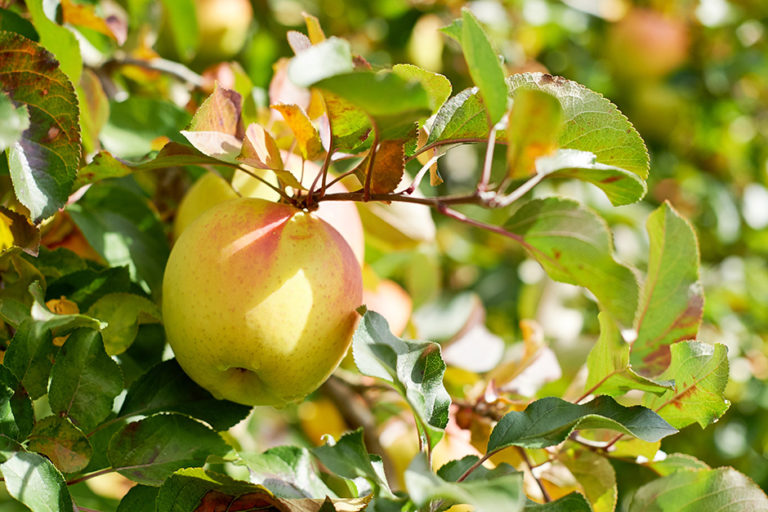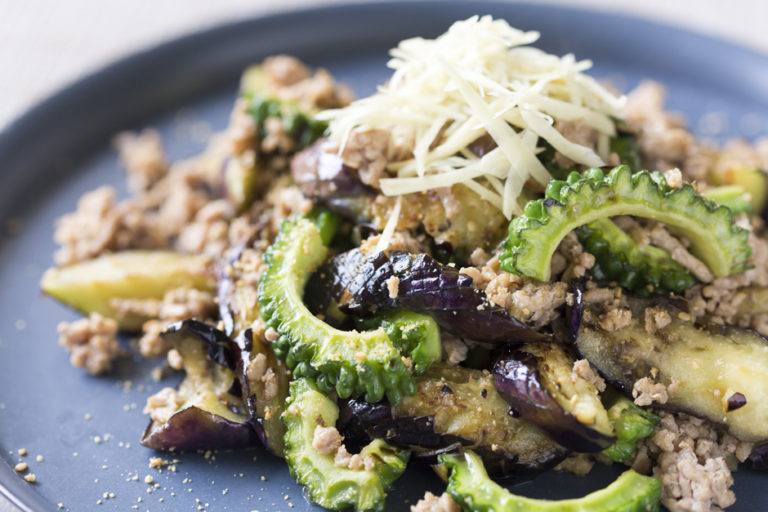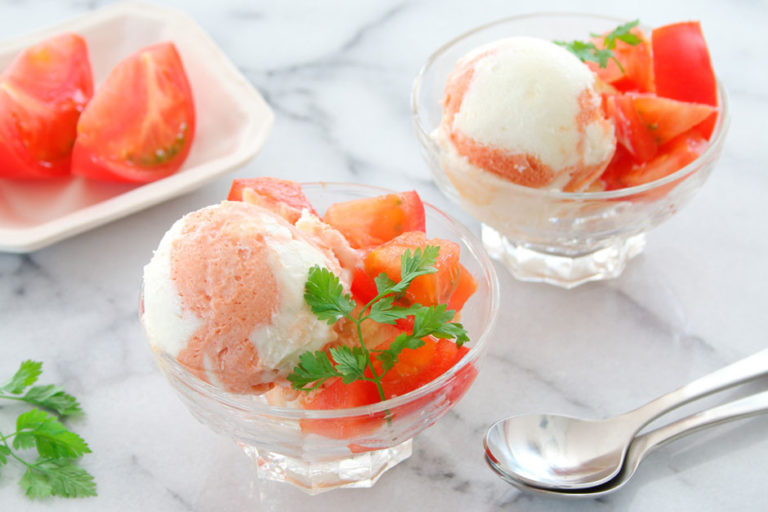The Challenges of a Konnyaku Shop in Hopes of Preserving Rare Native Species to Link to the Future
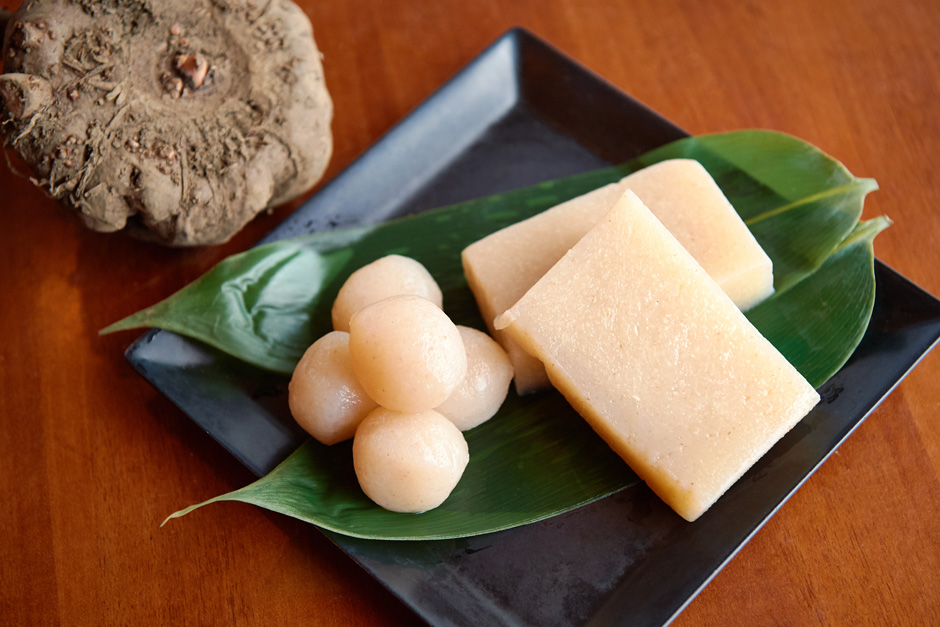
The store’s use of domestic ingredients and traditional manufacturing methods have not changed since the store’s founding. Although konnyaku has an image of being available all year round, Ooshimaya has recently been focusing on using native species of raw konnyaku yams to popularize in-season konnyaku products.
Ooshimaya focuses on domestic ingredients and traditional manufacturing methods
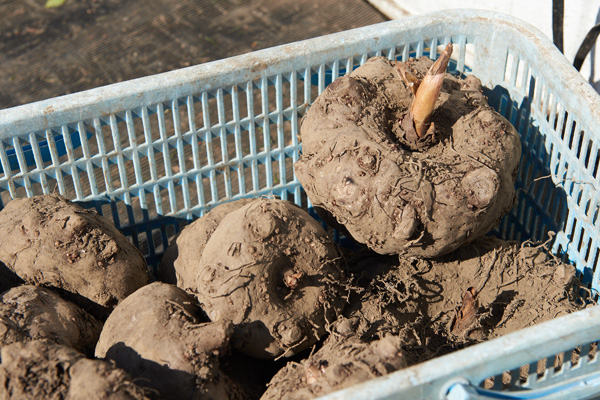
Konnyaku products are made from processed konnyaku yams, which initially have an extremely harsh taste, and cannot be eaten by simply boiling or roasting like other yams. This ingredient must have its harsh taste thoroughly removed, heated and processed into konnyaku products to be edible.
Gunma Prefecture is famous for its konnyaku products, and boasts the top harvest quantities in Japan, with 90% of all konnyaku yams harvested in Japan coming from there. Harvested konnyaku yams are usually dried, milled and distributed to manufacturers as konnyaku powder.
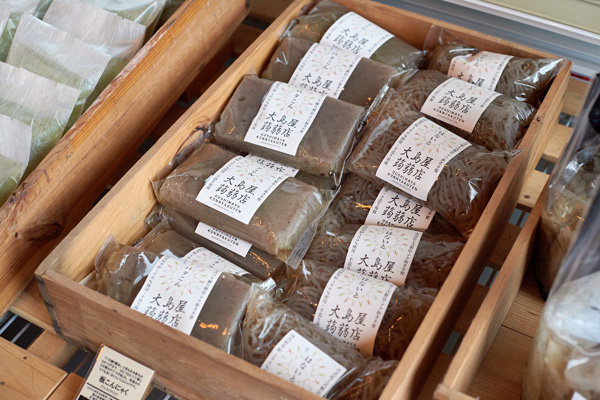
Ooshimaya, which operates a konnyaku store in Shirakawa, Fukushima Prefecture, also sells many products made from especially high-quality konnyaku powder from Gunma. The store uses the traditional bata-neri manufacturing method, which uses wooden planks to knead the konnyaku dough. All processes—from cutting konnyaku to packaging—are done by hand.
“The kneading process is crucial to making konnyaku. That is the reason why our store is locally called a neriya (kneading-store). Automated processes create too dense konnyaku, but bata-neri allows for a moderate amount of air bubbles to enter the konnyaku, causing it to soak up more flavor. These days, many manufacturers use imported raw ingredients, but high-quality konnyaku powder creates a smooth firmness,” explains Yusuke Yoshijima, the eighth-generation head of the Ooshimaya store.
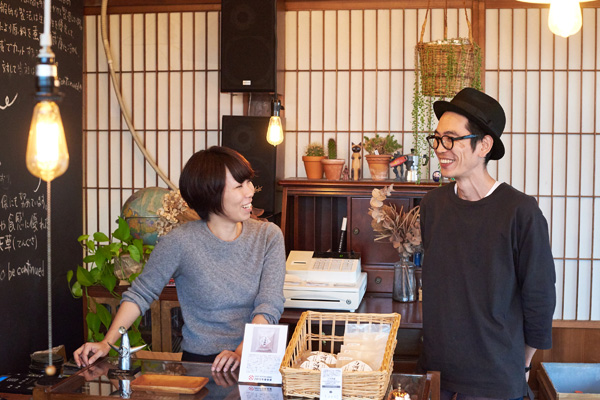
He inherited the family business from his wife, Kazue. Yusuke, his wife and Kazue’s father work together to make konnyaku. Originally, the family business had emphasized contract manufacturing, but in 2015, Ooshimaya opened its direct sales store Ooshimaya Konnyakuten in Shirakawa.
“We renovated some areas of our home to create this store. Many customers comment that it doesn’t look like a konnyaku shop at all,” says Kazue.
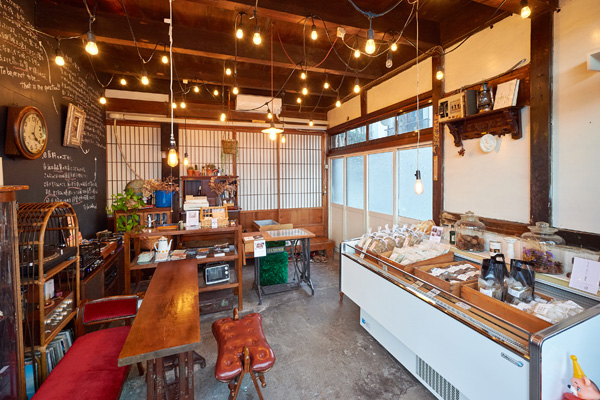
Just as Kazue said, the store interior shows the couple’s fondness for retro trinkets and furnishings, and has an ambience like a variety goods store. Among the plate-type konnyaku Batakon made by the bata-neri method, the konnyaku noodles Hanaito, or ball-type konnyaku Tamakon, the products Shirakawa Konnyaku are displayed in prominent locations. These products, which bear the name of the local city, are the products Ooshimaya is focusing on at the moment.
The rare konnyaku yam that makes up of only 2% of domestic produce
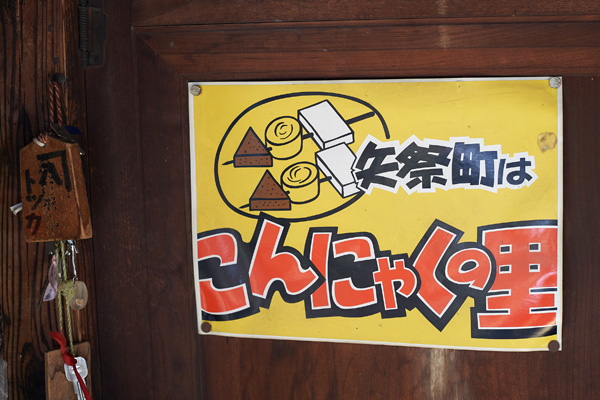
The main characteristic of Shirakawa Konnyaku is its ingredient. It is made from a native konnyaku yam that is grown in neighboring Yamatsuri in Higashi-Shirakawa County. This konnyaku yam is commonly known as Wadama.
It is said that this native variety of konnyaku yam came from the Mito Domain during the mid-Edo period (18th century). Yamatsuri prospered as a produce center for this native yam, and the entire region used to consist of konnyaku yam fields. This variety takes three years to grow to a size that can be shipped, and since it is susceptible to disease it traded at high prices in the past. Farms and retailers prospered, and it is said that many “konnyaku mansions” were built.
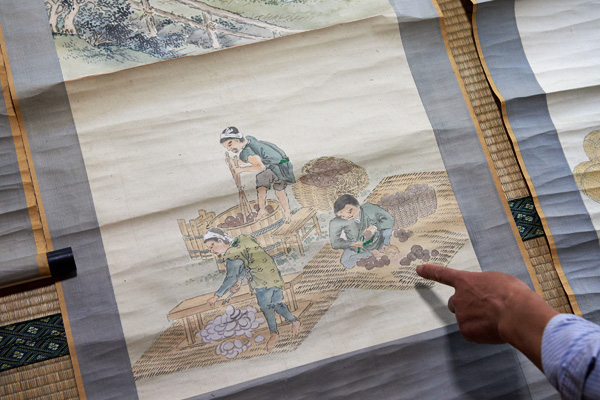
However, improved yam varieties were developed at the end of the 1970s and the situation changed dramatically. Konnyaku yams that were able to withstand disease and be harvested in two years started to replace of the native species. Shortly, Gunma Prefecture became the main area of produce and konnyaku started being distributed year round. With this, the Yamatsuri konnyaku fields started to shrink, and currently only 2% of all konnyaku yams produced in Japan are native variations.
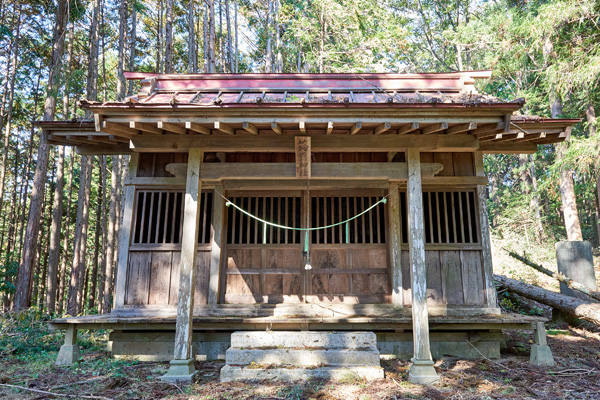
“There was even a Konnyaku shrine constructed to pray for good harvests when konnyaku farming was still prospering. Families in this region used to make their own konnyaku using native yams, but now this has become a rarity. As a matter of fact, I had never tried a native yam before. I felt strongly that as a konnyaku store in Fukushima, we should be using konnyaku yams from within the prefecture,” says Kazue.
In this environment, there was a local newspaper article about eleven farmers in Yamatsuri that have been making efforts toward preserving native species of konnyaku yams. Once the Yoshijimas caught wind of this activity, they consulted Yamatsuri Town Hall to get in contact with these farmers.
Cooperation with local farmers to preserve native konnyaku yams
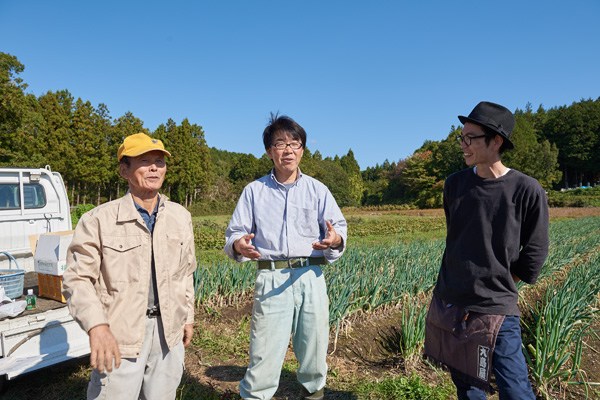
Yamatsuri Town Hall introduced Moriyoshi and Keijin Katano to the Yoshijimas. Moriyoshi is a veteran konnyaku farmer with 60 years of experience. He had been growing native konnyaku yams in one area of his farm, to preserve and carry on the culture of native konnyaku.
Moriyoshi was quite bewildered at first when the couple asked him if they could purchase all the native konnyaku yams he had. The couple helped with planting and harvesting to establish a relationship of trust a little at a time.
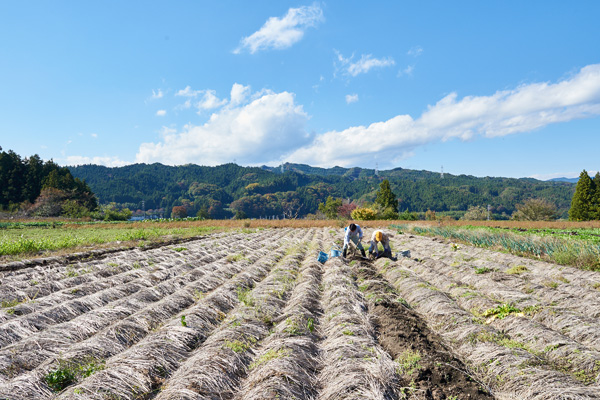
“Konnyaku yam planting starts in May. The seed yams are harvested at the end of November and pass the winter in a storage warehouse. This completes the first-year cycle. When spring comes again, the seed is planted once more for the second-year cycle, and the konnyaku yams are ready for shipment in the winter of the third year. We recognized how much work it takes to preserve native konnyaku yams,” reflects Kazue.
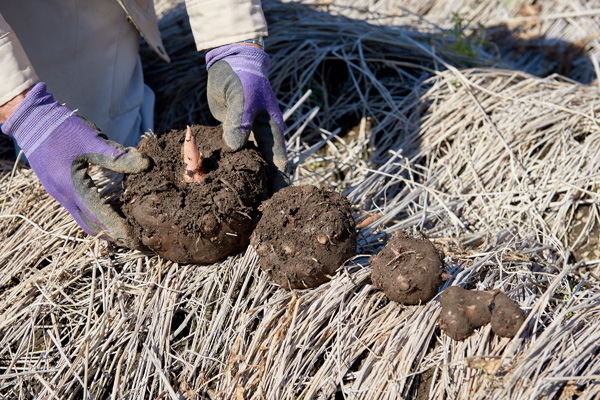
Currently, Ooshimaya does business with all eleven konnyaku yam farmers.
“Seasonal” konnyaku made with care
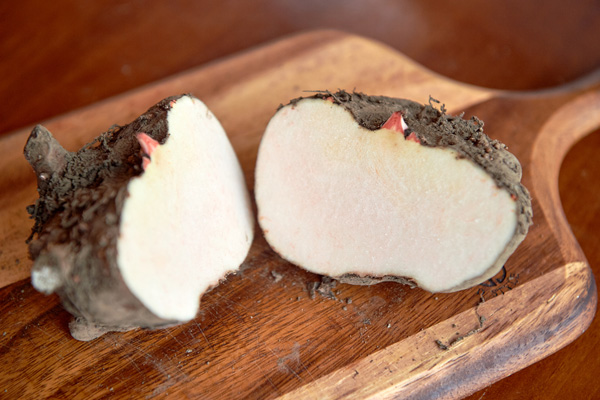
The ingredients are not the only point of focus for Ooshimaya’s Shirakawa Konnyaku. This product sticks to using fresh konnyaku yams in manufacturing, although powdered konnyaku is the current mainstream ingredient.
The initial issue the Yoshijimas ran into when developing this product was finding a recipe using fresh konnyaku yams.
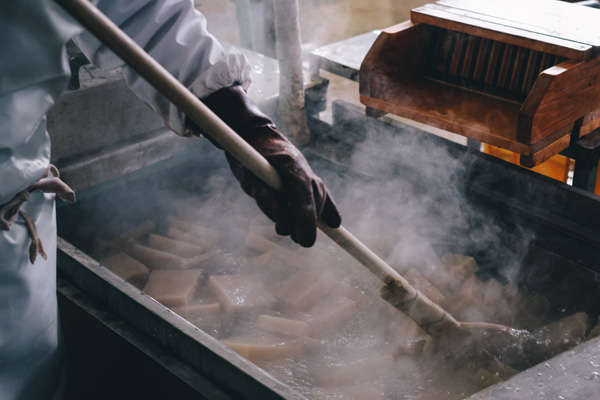
Ooshimaya had already switched over from fresh konnyaku yams to powder when Kazue’s great-grandfather was the head of the business, and there were no existing recipes for raw konnyaku yams. Furthermore, because recipes for raw konnyaku yams differed between each household and manufacturer, the couple went through a long battle of trial-and-error before arriving at the ideal konnyaku recipe.
“The texture changes dramatically with only a slight difference in water quantity. Many factors in manufacturing depend on the maker’s instincts. The entire process is done by hand, which is why it takes the three of us two whole days to make konnyaku. I guess other manufacturers wouldn’t dare to copy us if they knew how much work is put into these products,” laughs Yusuke.
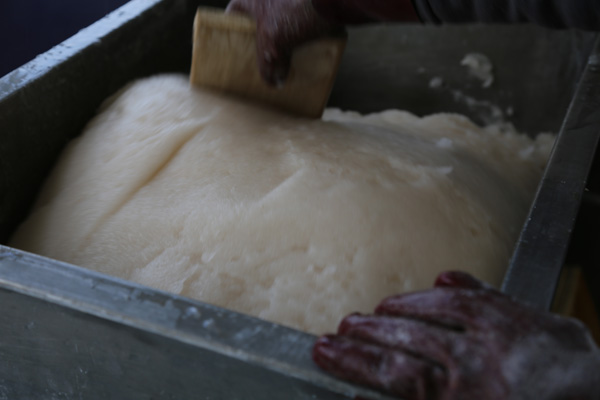
Shirakawa Konnyaku extravagantly uses only the center of the yam after the skin has been peeled. As Yusuke says, it’s the “daiginjo (A-list sake) of konnyaku”
Currently, Shirakawa Konnyaku features plate-type konnyaku and ball-type konnyaku. Both feature a smooth texture without any harsh or unpleasant tastes. One can experience the wonderful flavor by stir-frying with mentsuyu (noodle soup) or lightly cooking with shirodashi (white soy sauce with soup stock).
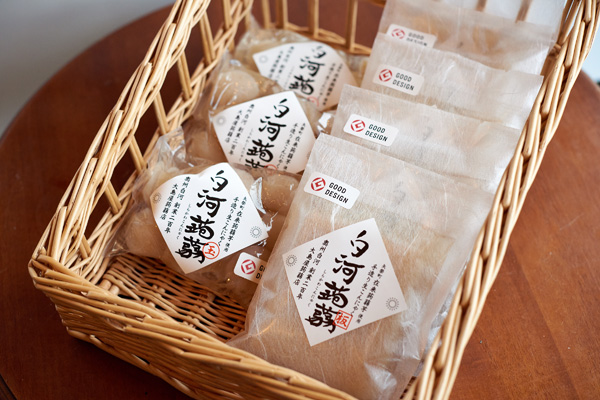
The konnyaku yams Ooshimaya purchases are the freshest ones right after harvest. In other words, the period between December and January is the season for Shirakawa Konnyaku. Once the season for fresh yam passes, konnyaku takes on another different taste. A moderate amount of moisture evaporates from Konnyaku yams that have been stored for a while, which results in konnyaku perfect for deep-frying or broiling.
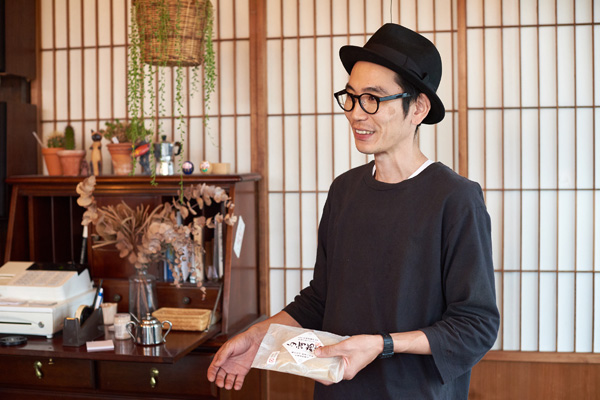
“Even konnyaku has a ‘seasonal’ flavor. I believe it is our duty as a konnyaku shop to communicate this fact. We are extremely proud of this, but on the other hand, we need to keep the business afloat. We have to contrive ways to acquire many customers, so we won’t end up just showing off,” says Yusuke, looking toward the future.
Ooshimaya’s Shirakawa Konnyaku has been highly rated for its activities toward preserving native yam species and its packaging design, and received the Good Design Award 2018. We look forward to Ooshimaya taking the next step for as it gains momentum!

